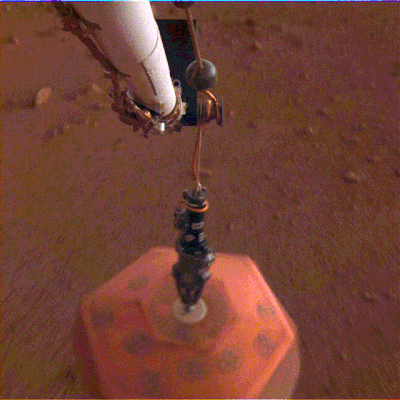It looks like you're using an Ad Blocker.
Please white-list or disable AboveTopSecret.com in your ad-blocking tool.
Thank you.
Some features of ATS will be disabled while you continue to use an ad-blocker.
4
share:

The instrument is a seismometer known as the Seismic Experiment for Interior Structure, or SEIS. The seismometer is one of the most important instruments for InSight's mission -- a mission that is intended to study the deep interior of Mars in an attempt to better understand the physical structure of the planet (core, mantle, etc.
"Seismometer deployment is as important as landing InSight on Mars," said InSight Principal Investigator Bruce Banerdt, also based at JPL. "The seismometer is the highest-priority instrument on InSight: We need it in order to complete about three-quarters of our science objectives."
The seismometer allows scientists to peer into the Martian interior by studying ground motion - also known as marsquakes. Each marsquake acts as a kind of flashbulb that illuminates the structure of the planet's interior. By analyzing how seismic waves pass through the layers of the planet, scientists can deduce the depth and composition of these layers.
www.jpl.nasa.gov...
Information on the SEIS instrument:
SEIS instrument webpage from JPL
InSight’s seismometer, SEIS, the Seismic Experiment for Interior Structure, is a round, dome-shaped instrument that sits on the Martian surface and takes the "pulse" or seismic vibrations of Mars. Its measurements provide a glimpse into the planet’s internal activity. The seismometer waits patiently to sense the pulse, or seismic waves, from marsquakes, and thumps of meteorite impacts. A suite of wind, pressure, temperature, and magnetic field sensors help fine-tune the seismometer's measurements. This helps it sense surface vibrations generated by weather systems such as dust storms, or by turbulence in the atmosphere due to phenomena such as dust devils, which can also generate seismic waves. SEIS measurements tell scientists about the nature of the material that first formed the rocky planets of the Solar System. As it reveals what lies beneath, the seismometer may even be able to tell us if there's liquid water, or plumes of active volcanoes underneath the Martian surface.
a reply to: Soylent Green Is People
Looking forward to news of Marsquakes and discovery of the inner workings of the red one , hoping it will deliver unexpected results.
Will they be able to detect inner voids within the planet ?, I wonder how much water is down there.
Looking forward to news of Marsquakes and discovery of the inner workings of the red one , hoping it will deliver unexpected results.
Will they be able to detect inner voids within the planet ?, I wonder how much water is down there.
a reply to: Soylent Green Is People
Looks like JPL will be busy in January, my neighbor's son works at JPL.
From your link: (thanks for posting this)
...in early January, engineers expect to command the robotic arm to place the Wind and Thermal Shield over the seismometer to stabilize the environment around the sensors.
Assuming that there are no unexpected issues, the InSight team plans to deploy the heat probe onto the Martian surface by late January. HP3 will be on the east side of the lander's work space, roughly the same distance away from the lander as the seismometer.
Looks like JPL will be busy in January, my neighbor's son works at JPL.
From your link: (thanks for posting this)
...in early January, engineers expect to command the robotic arm to place the Wind and Thermal Shield over the seismometer to stabilize the environment around the sensors.
Assuming that there are no unexpected issues, the InSight team plans to deploy the heat probe onto the Martian surface by late January. HP3 will be on the east side of the lander's work space, roughly the same distance away from the lander as the seismometer.
new topics
-
Cold Blooded Killers on Christmas!! GRRRRrrr!!
Pets: 6 hours ago -
Plane Crash Today --Azerbaijanian E190 passenger jet
Mainstream News: 11 hours ago
top topics
-
Orange County Makes Shoplifting a Felony
Other Current Events: 15 hours ago, 17 flags -
It's Offical Now
US Political Madness: 17 hours ago, 15 flags -
Cold Blooded Killers on Christmas!! GRRRRrrr!!
Pets: 6 hours ago, 8 flags -
Plane Crash Today --Azerbaijanian E190 passenger jet
Mainstream News: 11 hours ago, 6 flags
4
